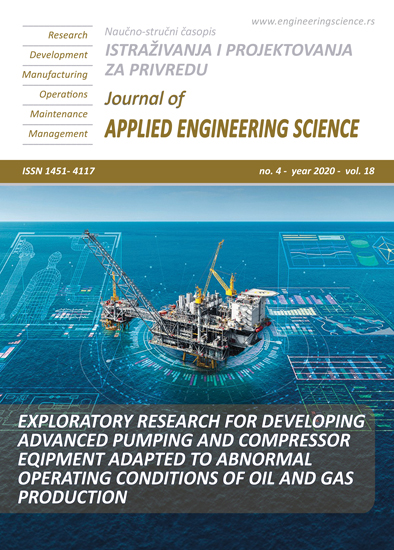APPLICATION OF MECHANICAL FILTERS FOR PURIFICATION OF ELECTROLYTE FROM SOLID PRODUCTS OF THE AIR AND ALUMINUM CHEMICAL CELL REACTION
Abstract
This work presents the results of the development and application of a filtration unit – a cartridge filter with a throttle (discharge) hole – for separating the solid phase – crystalline aluminum hydroxide Al(OH)3, formed during long-term operation of an air and aluminum chemical cell with alkaline electrolyte and power plants based on them. The main theoretical provisions on the filtration mechanism using the discharge hole are formulated, according to which the filtration process consists of two types of filtration – blowout piping and particle coupling. The developed method made it possible to: purify electrolyte with low friction to electrolyte flow at high concentrations of the solid phase (more than 10-15 mass %); ensure long-term performance of the purification system with large masses of the solid phase formed; be able to quickly regenerate the electrolyte; have a small mass and volume; leave a sufficient amount of solid phase in the electrolyte so that the crystals of aluminum hydroxide passing through the filter are a seed for the crystallization of dissolved aluminum in the circuit. The studies carried out allowed us to conclude that the use of mechanical cartridge filters with an orifice hole is an effective and reliable method for cleaning the electrolyte of a power plant with an air and aluminum chemical cell.
References
Farmakovskaya, A., Okorokova, N., Pushkin, K., Sevruk, S., Suvorova, E. (2019). Electrolyte for hydronic chemical current source used as hydrogen generator with aluminum anode. Collection of the 2018 International Theoretical and Practical Conference on Alternative and Smart Energy TPCASE 2018. DtSceh Publication, Inc., Lancaster, p. 224-230.
Farmakovskaya, A., Okorokova, N., Pushkin, K., Sevruk, S., Suvorova, E. (2019). Energy characteristics of a combined power plant based on a hydronic chemical current source. Collection of the 2018 International Theoretical and Practical Conference on Alternative and Smart Energy TPCASE 2018.DtSceh Publication, Inc., Lancaster, p. 231-237.
Chen, X., Zhang, Y., Ribeiorinha, P., Li, H., Kong, X.,Boaventura, M. (2018). A proton conductor electrolyte based on Molten CsH5(PO4)2 for intermediate-temperature fuel cells. RSC Advances, vol. 8, no. 10, 5225-5232,Doi: 10.1039/c7ra12803g.
Farmakovskaya, A.A., Shtekher, S.M. (1979). The study of mutual solubility in the system КОН-Аl(О)3-Н2О under 20oС. Collection Physic-Chemical Studies of Solutions and Melts of Electrochemical Systems and Systems. MAI, Moscow, p. 41-44.
Czarnetzki, W., Sevruk, S., Schneider, W., Khatskevych, Yu., Pushkin, K., Lutsenko, I., Rukhlov, A., Pivnyak, G., Beshta, O., Alekseyev, M. (2017). The development of electric alkaline electrochemical fuel cell hybrid system. 2016 Annual Proceedings, p. 33-45, DOI:10.1201/9781315197814-7.
Zaitsev, A.N., Strebkov, Y.S., Leshukov, A.Y., Ivanov, V.M., Kuksenova, L.I., Sachek, B.Y., Mezrin, A.M., Aleksandrova, Y.P. (2016). Assessment of critical level of shear stresses in tribocouples of Аl2O3 and metal details of ITER blanket modules. Journal of Machinery Manufacture and Reliability, vol. 45, no. 6, 522-530.
Hu, J., He, P., Zhang, B., Wang, B., Fan, L.-Z. (2020). Porous film host-derived 3D composite polymer electrolyte for high-voltage solid state lithium batteries. Energy Storage Materials, vol. 26, 283-289, Doi: 10.1016/j.ensm.2020.01.006.
Okorokova, N.S., Perchenok, A.V., Suvorova, E.V., Farmakovskaya, A.A. (2019). Purification of alkaline electrolyte from dissolved reaction products during work of the air-aluminum chemical current source. PeriodicoTcheQuímica, vol. 16, no. 33, 337-350.
Pushkin, K.V., Sevruk, S.D., Okorokova, N.S., Farmakovskaya, A.A. (2018). The most efficient corrosion inhibitors for aluminum anode of electrochemical cell used as a controlled hydrogen generator. Periodico Tche Quimica, vol. 15, no. S1, 414-425.
Farmakovskaya, A.A., Perchenok, A.V., Romanenkov, A.V. (1990). Russian utility patent No 1604390 “Separator for crystallization of aluminate solutions”. MAI, Moscow.
Pushkin, K.V.,Sevruk, S.D., Suvorova, E.V., Farmakovskaya, A.A. (2015). Development of a method for the regeneration of an alkaline electrolyte in an air–aluminum chemical power supply. Russian Metallurgy (Metally), vol. 13, 1179-1184.
Okorokova, N.S., Sevruk, S.D., Suvorova, E.V., Farmakovskaya, A.A. (2015). Solid reaction products and aluminate solutions that form during the operation of an air-aluminum chemical power supply. Russian Metallurgy (Metally), vol. 13, 1174-1178.
Farmakovskaya, A.A., Popov, V.V., Sevruk, S.D., Tumanov, B.I., Udaltsov, V.G. (2003). Oxygen-aluminum fuel cells and most practical fields of their applications. Fuel Cell Science, Engineering and Technology. ASME, New York, p. 273-277.
Okorokova, N.S., Prokofev, M.V., Pushkin, K.V., Sevruk, S.D., Suvorova, E.V., Farmakovskaya, A.A. (2015). The possibility of using alkaline-stannate electrolytes in a hydronic chemical current source as a hydrogen generator. Proceedings of MAI, no. 83, http://www.mai.ru/science/trudy/published.php?ID=62119.
Kim, C., Kim, S., Jang, I., Yoon, H., Song, T., Paik, U. (2019). Facile fabrication strategy of highly dense gadolinium-doped ceria/yttria-stabilized zirconia bilayer electrolyte via cold isostatic pressing for low temperature solid oxide fuel cells.Journal of Power Sources, vol. 415, 112-118,Doi: 10.1016/j.jpowsour.2019.01.057.
Mathur, L., Kim, I.-H., Bhardwaj, A., Singh, B., Park, J.-Y., Song, S.-J. (2020). Structural and electrical properties of novel phosphate based composite electrolyte for low-temperature fuel cells. Composites Part B: Engineering, vol. 202, no. 108405,Doi: 10.1016/j.compositesb.2020.108405.
Rajagopal, R., Ryu, K.-S. (2020). Evaluation of Li6P2S8I solid electrolyte for all solid-state lithium battery applications. Chemical Engineering Journal, vol. 402, no. 123179,Doi: 10.1016/j.cej.2020.126179.
Astapov, A.N., Zhestkov, B.E., Lifanov, I.P.,Rabinskiy, L.N.,Terentieva, V.S. (2019). Erosion-resistant enhancement of anti-oxidation coatings in hypersonic flows of air plasma. Arabian Journal for Science and Engineering, vol. 44, 5323-5334.
Astapov, A.N., Rabinskiy, L.N.,Terentieva, V.S. (2019). State in the field of heat-resistant coatings for heat-proof nickel alloys and steels. Periodico Tche Quimica, vol. 16, no. 33, 561-572.
Babaytsev, A.V., Rabinskiy, L.N. (2019). Design calculation technique for thick-walled composite constructions operating under high-speed loading. Periodico Tche Quimica, vol. 16, no. 33, 480-489.
Skvortsov, A.A., Zuev, S.M., Koryachko, M.V. (2018). Contact melting of aluminum-silicon structures under conditions of thermal shock. Key Engineering Materials, vol. 771, 118-123.
Dinzhos, R.V., Lysenkov, E.A., Fialko, N.M. (2015). Features of thermal conductivity of composites based on thermoplastic polymers and aluminum particles. Journal of Nano- and Electronic Physics, vol. 7, no. 3, 03022.
Dinzhos, R.V., Lysenkov, E.A., Fialko, N.M. (2015). Influence of fabrication method and type of the filler on the thermal properties of nanocomposites based on polypropylene. Voprosy Khimii i Khimicheskoi Tekhnologii, vol. 5, no. 103, 56-62.

